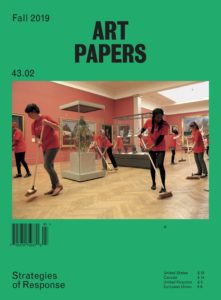target (n.)
Occupy Museums, Debtfair, 2017, Whitney Museum of American Art, New York [photo: Kenneth Pietrobono]
Share:
“This is not an issue about Art and Activism.”
Art (n.): A slippery notion. Its boundaries are articulated, and it is assigned value, by a web of overlapping institutions, typically with origins in the global West, that endows certain kinds of creative practices and outputs with particular social capital. Perhaps, years ago, the contours of art emerged from the soil. Today, the task of policing the borders of art is undertaken by a specialized and powerful elite. But art is also an expression of an eternal human-ness, the product of our yearning for connection, our release of powerful feelings, and the place that our capacities for communication, imagination, and abstraction intersect. However, this latter definition may itself be a product of institutionalized fictions, as it is particularly linked to claims regarding the divine value of human life and the all-too-alienable right of humans to a dignified life.
Institutions (n., pl.): Intersubjective entities. They are imposed mechanisms of social order as much as they are emergent patterns of social self-organization. They blossom whenever humans come together to mediate the spaces between us and govern our behavior. We live and breathe an institutional reality that infuses our experiences with meaning. Customs and values are known as informal institutions. They tend to be deeply ingrained and seem to emerge naturally from a collective consciousness. They interact intimately with formal institutions, such as a government and legal system, a museum, or a military, all of which have a center, an identifiable and often written code of practices with clear processes in place for making specific structural alterations.
Fictions (n., pl.): Fabricated stories describing imaginary events. On the surface, they stand in contrast with facts, yet ironically, fictions, after physics, are perhaps the most powerful forces in our lives. Fictions are not nonsense. They are told precisely because they resonate with the lived experiences, norms, customs, and values the tellers hold dear. Fictions serve therefore to legitimate who we are and the institutions we uphold. Believable fabrications, they are both inventions of our expansive imaginations and constrained by the need to exist within commonly accepted realms of possibility. Imaginations often push and pull at the extremes of such realms, so fiction plays a vital role in defining and redefining what we think is possible. This glossary is a fiction.
Aesthetics (n., pl.): A kind of fiction, too. The word refers to a branch of philosophy concerned with notions of beauty. More fundamentally, though, it describes a practice, process, experience of, and capacity for sensitizing one’s self to lived experiences. Whereas its opposite, anesthetics, is practiced in order to provide subjects a lack of feeling, aesthetic practices are aimed at strengthening or developing senses and sensitivities. They give meaning to sensual phenomena, which in themselves affect not just what and how we feel, but what we desire to feel and what we believe it is possible to feel.
Care (n.): A quality of feeling that spurs action.
Target (n.): The object one intends to affect with an action. Recent targets have included Warren Kanders, David Koch, Larry D. Fink, BP, and the Sackler Family. Targets are frequently not individual people themselves but rather the institutions they represent. Choosing a target is an aesthetic practice. The choice should evoke feelings strong enough—such as anger, love, fear, joy, or disgust—to spur action. These actions should be aimed at affecting the feelings of others, urging them in turn to perform aesthetic interventions of their own. What could result is a community of care that acts together to release powerful feelings, push the boundaries of our imaginations, and, possibly, create fictions powerful enough to rewrite our relationships with the institutions that govern us.
This glossary originally appeared in ART PAPERS Fall 2019 “Strategies of Response.” 
Tal Beery is cofounder of Eco Practicum, an artist-run school for ecological justice and founding faculty at School of Apocalypse, examining the connections between creative practice and notions of survival. Beery is also a core member of Occupy Museums, a collective fighting the economic and social injustices propagated by institutions of art and culture. His curatorial research considers the relationships between art, institutions, and epochal change.